Assessing Endokarst Potential in the Northern Sector of Santo António Plateau (Estremadura Limestone Massif, Central Portugal)
Abstract
:1. Introduction
2. Study Area
3. Material and Methods
3.1. Data Collection and Pre-Processing
3.2. Model-Building Strategy
4. Results and Discussion
5. Conclusions
Author Contributions
Funding
Institutional Review Board Statement
Informed Consent Statement
Data Availability Statement
Acknowledgments
Conflicts of Interest
References
- White, W.B. Geomorphology and Hydrology of Karst Terrains; O.U.P.: New York, NY, USA, 1988. [Google Scholar]
- Ford, D.; Williams, P. Karst Geomorphology and Hydrology; John Wiley & Sons, Ltd.: Hoboken, NJ, USA, 2007. [Google Scholar]
- Dimuccio, A.L. A Carsificação Nas Colinas Dolomíticas a Sul de COIMBRA (Portugal Centro-Ocidental—Fáceis Deposicionais e Controlos Estratigráficos do (Paleo)Carso no Grupo de Coimbra (Jurássico Inferior). Ph.D. Thesis, Departamento de Ciências da Terra da Faculdade de Ciências e Tecnologia da Universidade de Coimbra, Coimbra, Portugal, 2014. [Google Scholar]
- Tomlin, C.D. Geographic Information Systems and Cartographic Modeling; Prentice-Hall: Englewood Cliffs, NJ, USA, 1990. [Google Scholar]
- Tomlin, C.D. Cartographic Modeling in International Encyclopedia of Geography. Am. Cancer Soc. 2017, 1–6. [Google Scholar] [CrossRef]
- De Smith, M.J.; Goodchild, M.F.; Longley, P.A. Geospatial analysis and model building. In Geospatial Analysis: A Comprehensive Guide to Principles, Techniques and Software Tools, 6th ed.; Winchelsea Press: London, UK, 2018. [Google Scholar]
- Bolstad, P.; Manson, S. Chapter 13: Spatial Models and Modeling. In GIS Fundamentals: A First Text on Geographic Information Systems, 7th ed.; Eider Press: Saint Paul, MN, USA, 2022; pp. 561–582. [Google Scholar]
- Church, R.L. Geographical information systems and location science. Comput. Oper. Res. 2002, 29, 541–562. [Google Scholar] [CrossRef]
- Longley, P.A.; Goodchild, M.F.; Maguire, D.J.; Rhind, D.W. Geographic Information Systems & Science, 3rd ed.; John Wiley & Sons: Hoboken, NJ, USA, 2011. [Google Scholar]
- Huang, B. Comprehensive Geographic Information Systems; Huang, B., Thomas, J.C., Ming-Hsiang, T., Eds.; GIS methods and techniques; Elsevier: Amsterdam, The Netherlands, 2018; Volume 1. [Google Scholar]
- Gao, J. Fundamentals of Spatial Analysis and Modelling, 1st ed.; CRC Press: Boca Raton, FL, USA, 2021. [Google Scholar]
- Jennings, J.N. Karst Geomorphology; Oxford Blackwell: Oxford, UK, 1985. [Google Scholar]
- Cunha, L. Geomorfologia Estrutural e Cársica. In O Quaternário em Portugal, Balanço e Perspectivas; Colibri: Lisboa, Portugal, 1993; pp. 63–74. Available online: https://www.researchgate.net/profile/Lucio-Cunha-2/publication/324088980_Geomorfologia_estrutural_e_carsica/links/5abd07990f7e9bfc0457a68b/Geomorfologia-estrutural-e-carsica.pdf (accessed on 15 May 2023).
- Palmer, A.N. Cave Geology; Allen Press: Lawrence, KS, USA, 2007. [Google Scholar]
- Dimuccio, L.A. Tempo e espaço num geossistema cársico: Os “pilares” em que assenta e se sustenta a interpretação da sua evolução geológicogeomorfológica. In Espaços e Tempos em Geografia: Homenagem a António Gama; Imprensa da Universidade de Coimbra: Coimbra, Portugal, 2017; pp. 207–238. [Google Scholar]
- De Waele, J.; Gutierrez, F. Karst Hydrogeology, Geomorphology and Caves; John Wiley & Sons Ltd.: Hoboken, NJ, USA, 2022. [Google Scholar]
- Crispim, J.A. Dinâmica Cársica e Implicações Ambientais nas Depressões de Alvados e Minde. Ph.D. Thesis, Faculdade de Ciências da Universidade de Lisboa, Departamento de Geologia, Lisboa, Portugal, 1995. [Google Scholar]
- Rodrigues, L.M.E. Evolução Geomorfológica Quaternária e Dinâmica Actual. Aplicações ao Ordenamento do Território. Exemplos no Maciço Calcário Estremenho. Ph.D. Thesis, Universidade de Lisboa, Lisboa, Portugal, 1998. [Google Scholar]
- Brilha, J. Património Geológico e Geoconservação a Conservação da Natureza na Sua Componente Geológica; Palimage: Viseu, Portugal, 2005. [Google Scholar]
- Cunha, L.; Dimuccio, L.A.; Aubry, T. Património cársico no Centro de Portugal. O caso do Maciço de Sicó. Património Geomorfológico e Geoconservação. Experiências em Portugal e no Brasil. In Proceedings of the do I Encontro Luso-Brasileiro de Património Geomorfológico e Geoconservação, Coimbra, Portugal, 5–7 February 2014; pp. 27–34. [Google Scholar]
- Cunha, L.; Dimuccio, A.L.; Paiva, I. Geopatrimónio cársico e desenvolvimento local no Maciço de Sicó. Desafios para afirmar a Lusofonia na Geografia Física e Ambiente. II Encontro Luso-Afro-Americano de Geografia Física e Ambiente 2018. pp. 1227–1233. Available online: https://repositorio.ul.pt/handle/10451/36644 (accessed on 15 May 2023).
- Aleksandar, A.; Nemanja, T.; Slobodan, M. Karst geoheritage and geotourism potential in the Pek River lower basin (eastern Serbia). Geogr. Pannonica 2019, 23, 32–46. [Google Scholar]
- Khalaf, E.E.D.A.H. Karst Heritage as a Tourist Attraction: A Case Study in the White Desert National Park, Western Desert, Egypt. Geoheritage 2022, 14, 1–30. [Google Scholar] [CrossRef]
- Valjavec, M.B.; Pejnović, N.D.; Draženović, M.; Čonč, Š.; Horvat, K.P. The Transboundary Approach to Landscape Geointerpretation: Challenges in Interpretive Planning and Geoconservation. Geoheritage 2022, 14, 1–13. [Google Scholar] [CrossRef]
- Rodrigues, H.A.; Rodrigues, M.L.; Lobo, H.S. Espeleoturismo em Portugal: Panorama Geral do Uso Turístico das Cavidades Naturais. Rev. Rosa Dos Ventos-Tur. E Hosp. 2017, 9, 92–106. (In Brazilian) [Google Scholar]
- Torres, E.; Spoladore, A.; Cunha, L. Espeleoturismo: Nota preliminar sobre as realidades paranaense e portuguesa. In Paisagem e Território; UEL: Londrina, Brazil, 2018; pp. 83–88. [Google Scholar]
- Ballesteros, D.; Fernández-Martínez, E.; Carcavilla, L.; Jiménez-Sánchez, M. Karst Cave Geoheritage in Protected Areas: Characterisation and Proposals of Management of Deep Caves in the Picos de Europa National Park (Spain). Geoheritage 2019, 11, 1919–1939. [Google Scholar] [CrossRef]
- Chiarini, V.; Duckeck, J.; De Waele, J.A. Global Perspective on Sustainable Show Cave Tourism. Geoheritage 2022, 14, 1–27. [Google Scholar] [CrossRef]
- Hobléa, F. Expertise et Médiation Scientifique Pour la Gestion Durable de L’Environnement Karstique; Actes de la réunion annuelle de la Société Suisse de Géomorphologie (SSGm), Gestion durable de l’environnement karstique; Persée: Paris, France, 2004; pp. 25–42. [Google Scholar]
- Leslie, A.N. Informal Karst Education in the United States and Internationally. Ph.D. Thesis, Department of Geography, University of South Florida, Tampa, FL, USA, 2011. [Google Scholar]
- Abdellah, A.B.; Jamila, R.; Ahmed, B.; Elhassan, L.; Samir, N. The Karst Landscapes of Beni Mellal Atlas (Central Morocco): Identification for Promoting Geoconservation and Tourism. Quaest. Geogr. 2022, 41, 87–109. [Google Scholar]
- Velasquez, M.; Hester, P.T. An analysis of multi-criteria decision making methods. Int. J. Oper. Res. 2013, 10, 56–66. [Google Scholar]
- Zlaugotne, B.; Zihare, L.; Balode, L.; Kalnbalkite, A.; Khabdullin, A.; Blumberga, D. Multi-Criteria Decision Analysis Methods Comparison. Environ. Clim. Technol. 2020, 24, 454–471. [Google Scholar] [CrossRef]
- Vakilipour, S.; Sadeghi-Niaraki, A.; Ghodousi, M.; Choi, S. Comparison between Multi-Criteria Decision-Making Methods and Evaluating the Quality of Life at Different Spatial Levels. Sustainability 2021, 13, 4067. [Google Scholar] [CrossRef]
- Taheri, K.; Gutiérrez, F.; Mohseni, H.; Raeisi, E.; Taheri, M. Sinkhole susceptibility mapping using the analytical hierarchy process (AHP) and magnitude-frequency relationships: A case study in Hamadan province, Iran. Geomorphology 2015, 234, 64–79. [Google Scholar] [CrossRef]
- Moradi, S.; Kalantari, N.; Charchi, A. Karstification Potencial Mapping in Northeast of Khuzestan Province, Iran, using Logic and Analytical Hierarchy Process (AHP) techniques. Geopersia 2016, 6, 265–282. [Google Scholar]
- Zaree, M.; Javadi, S.; Neshat, A. Potential detection of water resources in karst formations using APLIS model and modification with AHP and TOPSIS. J. Earth Syst. Sci. 2019, 128, 76. [Google Scholar] [CrossRef]
- Vargas, H.S.; Almeida, J.A.; Kullberg, J.C.; Brito, M.G. Prospecção interactiva de endocarso através de uma aplicação SIG. Finisterra 2003, 38, 51–64. [Google Scholar]
- Aken, M.V.; Harley, G.L.; Dickens, J.F.; Polk, J.S.; North, L.A. A GIS-based modeling approach to predicting cave disturbance in karst landscapes: A case study from west-central Florida. Phys. Geogr. 2014, 35, 123–133. [Google Scholar] [CrossRef]
- Auler, A. Cave protection as a Karst conservation tool in the environmentally sensitive Lagoa Santa Karst, Southeastern Brazil. Acta Carsologica 2016, 45, 131–145. [Google Scholar] [CrossRef]
- Gunn, J.; Gillieson, D.; Auler, A.; Bolger, T. Guidelines for Cave and Karst Protection, 2nd ed.; International Union of Speleology: Postojna, Slovenia; IUCN: Gland, Switzerland, 2022. [Google Scholar]
- Theilen-Willige, B.; Malek, H.A.; Charif, A.; El Bchari, F.; Chaïbi, M. Remote Sensing and GIS Contribution to the Investigation of Karst Landscapes in NW-Morocco. Geosciences 2014, 4, 50–72. [Google Scholar] [CrossRef]
- Telbisz, T.; Mari, L.; Albert, G. GIS Research of Karst Terrains in Hungary. In Cave and Karst Systems of Hungary. Cave and Karst Systems of the World; Veress, M., Leél-Őssy, S., Eds.; Springer: Berlin/Heidelberg, Germany, 2022; pp. 249–274. [Google Scholar]
- Hamed, Y.; Hadji, R.; Ahmadi, R.; Ayadi, Y.; Shuhab, K.; Pulido-Bosch, A. Hydrogeological investigation of karst aquifers using an integrated geomorphological, geochemical, GIS, and remote sensing techniques (Southern Mediterranean Basin—Tunisia). Environ. Dev. Sustain. 2023, 1–33. [Google Scholar] [CrossRef]
- Cooper, A.; Farrant, A.; Price, S. Karst, GIS and geological hazard planning and management in Great Britain. In 2º Workshop Internazionale, I Sinkholes, Gli Sprofondamenti Catastrofici Nell’ambiente Naturale ed in Quello Antropizzato; Istituto Superiore per la Protezione e la Ricerca Ambientale: Rome, Italy, 2010; pp. 242–256. [Google Scholar]
- Zhang, C.; Qi, X.; Wang, K.; Zhang, M.; Yue, Y. The application of geospatial techniques in monitoring karst vegetation recovery in southwest China: A review. Prog. Phys. Geogr. Earth Environ. 2017, 41, 450–477. [Google Scholar] [CrossRef]
- Fathi, S.; Sjåstad, J.H.; Hoseen, A.H. Synthesizing existing frameworks to identify the potential for Managed Aquifer Recharge in a karstic and semi-arid region using GIS Multi Criteria Decision Analysis. Groundw. Sustain. Dev. 2020, 11, 100390. [Google Scholar] [CrossRef]
- Mokarram, M.; Mohammadizadeh, P. Prediction of karst suitable area using fuzzy AHP method and Dempster-Shafer theory. Earth Space Sci. 2021, 8, e2019EA000719. [Google Scholar] [CrossRef]
- Martins, A.F. Maciço Calcário Estremenho. Contribuição Para um Estudo de Geografia Física. Ph.D. Thesis, Faculdade de Letras da Universidade de Coimbra, Coimbra, Portugal, 1949. [Google Scholar]
- Rodrigues, M.L. The Limestone Massif of Estremadura. In Landscapes and Landforms of Portugal. World Geomorphological Landscapes; Vieira, G., Zêzere, J., Mora, C., Eds.; Springer: Berlin/Heidelberg, Germany, 2020; pp. 229–250. [Google Scholar]
- Fleury, E. Portugal Subterrâneo, Ensaio de Espeleologia Portuguesa; Coleção Natura: Lisboa, Portugal, 1925. [Google Scholar]
- Thomas, C. Cova da Velha. Espeleo Divulg. 1985, 4, 30–35. [Google Scholar]
- Ferreira, A.B.; Rodrigues, M.L.; Zêzere, J.L. Problemas da Evolução Geomorfológica do Maciço Calcário Estremenho. Finisterra 1988, 23, 5–28. [Google Scholar] [CrossRef]
- Crispim, J.A. Características cársicas das rochas carbonatadas da região central do Maciço Calcário Estremenho. Algar Bol. Soc. Port. De Espeleol. 1992, 3, 9–18. [Google Scholar]
- Canais, F.; Fernandes, J. Lapas e Algares da Serra de Santo António; SubTerra—Grupo de Espeleologia: Torres Novas, Portugal, 1999. [Google Scholar]
- Azerêdo, A.C. Jurássico Médio do Maciço Calcário Estremenho (Bacia Lusitânica): Análise de fácies, micropaleontologia, paleogeografia. Ph.D. Thesis, Departamento de Geologia da Faculdade de Ciências da Universidade de Lisboa, Lisboa, Portugal, 1993. [Google Scholar]
- Azerêdo, A.C. Geometry and facies dynamics of Middle Jurassic carbonate ramp sandbodies. West-Central Portugal. Geol. Soc. Lond. Spéc. Publ. 1998, 149, 281–314. [Google Scholar] [CrossRef]
- Inês, N. Paleotipologias Diagenéticas em Formações Carbonatadas do Jurássico Médio da Bacia Lusitânica: Análise Multiscala e Aplicações à Caraterização de Reservatórios. Master’s Thesis, Estratigrafia, Sedimentalogia e Palentologia, Departamento de Geologia da Faculdade de Ciências da Universidade de Lisboa, Lisboa, Portugal, 2010. [Google Scholar]
- Carvalho, J.M. Tectónica e caraterização da fraturação do Maciço Calcário Estremenho, Bacia Lusitânica. Contributo para a Prospeção de Rochas Ornamentais e Ordenamento da Atividade Extrativa. Ph.D. Thesis, Departamento de Geologia da Faculdade de Ciências da Universidade de Lisboa, Lisboa, Portugal, 2013. [Google Scholar]
- Rocha, R.B.; Soares, A.F. Algumas reflexões sobre a sedimentação jurássica na orla meso-cenozóica ocidental de Portugal. Mem. Notícias Univ. Coimbra 1984, 97, 133–142. [Google Scholar]
- Kullberg, J.C.; Rocha, R.B.; Soares, A.F.; Rey, J.; Terrinha, P.; Axerêdo, A.C.; Callapez, P.; Duarte, L.V.; Kullberg, M.C.; Martins, L.; et al. A Bacia Lusitaniana: Estratigrafia, Paleogeografia e Tectónica. In Portugal, Vol. II, Geologia Meso-Cenozóica de Portugal. Escolar Editora; Dias, R., Araújo, A., Terrinha, P., Kullberg, C., Eds.; Escolar Editora: Lisboa, Portugal, 2013; pp. 195–347. [Google Scholar]
- Daveau, S. O Relevo de Portugal. Grandes Unidades Regionais; Feio, M., Daveau, S., Eds.; Associação Portuguesa de Geomorfólogos: Coimbra, Portugal, 2004; pp. 61–73. [Google Scholar]
- Saaty, T.L. A scaling method for priorities in hierarchical structures. J. Math. Psychol. 1977, 15, 234–281. [Google Scholar] [CrossRef]
- Saaty, T.L. Axiomatic foundation of the analytic hierarchy process. Manag. Sci. 1986, 32, 841–855. [Google Scholar] [CrossRef]
- Saaty, T.L. Theory and Applications of the Analytic Network Process: Decision Making with Benefits, Opportunities, Costs, and Risks; RWS Publications: Pittsburg, PA, USA, 2009. [Google Scholar]
- Ishizaka, A.; Labib, A. Analytic Hierarchy Process and Expert Choice: Benefits and limitations. Oper. Reasearch Soc. 2009, 22, 201–220. [Google Scholar] [CrossRef]
- Saaty, T.L.; Ergu, D. When is a Decision-Making Method Trustworthy? Criteira for Evaluating Multi-Criteria Decision-Making Methods. Int. J. Inf. Technol. Decis. Mak. 2015, 14, 1171–1187. [Google Scholar] [CrossRef]
- Bi, J.; Bennett, K.P. Regression Error Characteristic Curves. In Proceedings of the Twentieth International Conference on Machine Learning 2003, (ICML-2003), Washington, DC, USA, 23–24 June 2003; pp. 43–50. [Google Scholar]
- Oliveira, S.M.C. Incidência Espacial e Temporal da Instabilidade Geomorfológica na Bacia do Rio Grande da Pipa (Arruda dos Vinhos). Ph.D. Thesis, Universidade de Lisboa, Lisboa, Portugal, 2012. [Google Scholar]
- Klimchouk, A.; Ford, D.; Palmer, A.; Dreybrodt, W. Spleogenesis, Evolution of Karst Aquifers; National Speleological Society January: Huntsville, AL, USA, 2000; 527p. [Google Scholar]
- Paiva, I.M.R. Hidrossistema Cársico de Dregracias-Sicó. Estudo do Funcionamento Hidrodinâmico a Partir das Suas Respostas Naturais. Ph.D. Thesis, Faculdade de Letras da Universidade de Coimbra, Coimbra, Portugal, 2014. [Google Scholar]
- Seif, A.; Ebrahimi, B. Using GIS to evaluate degree of karstification according to some important factors in carbonate rocks in Iran. Carbonate Evaporites 2014, 29, 107–126. [Google Scholar] [CrossRef]
- Nola, I.T.S.; Bacellar, L.A.P. Multi-criteria analysis for mapping susceptibility to iron formation caves development in the Gandarela mountain range (MG), southeast Brazil. Int. J. Speleol. 2021, 50, 137–187. [Google Scholar] [CrossRef]
- Al-shabeeb, A.R. The Use of AHP within GIS in Selecting Potential Sites for Water Harvesting Sites in the Azraq Basin—Jordan. J. Geogr. Inf. Syst. 2016, 8, 73–88. [Google Scholar] [CrossRef]
- Azerêdo, A.C. Formalização da litostratigrafia do Jurássico Inferior e Médio do Maciço Calcário Estremenho (Bacia Lusitânica). Comun. Geológicas 2007, 94, 29–51. [Google Scholar]
- Salomon, J.N. Précis de Krastologie; Presses Universitaries de Bourdeaux: Bourdeaux, France, 2000. [Google Scholar]
- Figueiredo, R.F. Modelação Cartográfica em Ambiente SIG Para Apoio à Decisão: Aplicação ao Estudo da Afectação Potencial de Usos do Solo no Sector Norte do Maciço Marginal de Coimbra. Master’s Thesis, Faculdade de Letras da Universidade de Coimbra, Coimbra, Portugal, 2001. [Google Scholar]
- Ramos, A.; Cunha, L.; Cunha, P. Application de la Méthode de l’Analyse Multicritère Hiérarchique à l’étude des glissements de terrain dans la région littorale du centre du Portugal: Figueira da Foz—Nazaré. Geo-Eco-Trop Liège 2014, 38, 33–44. [Google Scholar]
- Fielding, A.H.; Bell, J.F. A review of methods for the assessment of prediction errors in conservation presence/absence models. Environ. Conserv. 1997, 24, 38–49. [Google Scholar] [CrossRef]
- Bennett, B.; Ibrahim, A.M. The Assessment of Machine Learning Model Performance for Predicting Alluvial Deposits Distribution. Procedia Comput. Sci. 2014, 36, 637–642. [Google Scholar]
- Saaty, T.L. How to make a decision: The analytic hierarchy process. Eur. J. Oper. Res. 1990, 48, 9–26. [Google Scholar] [CrossRef]
- Hämäläinen, R.P.; Salo, A.A. The Issue is Understanding the Weights. J. Multi-Criteria Decis. Anal. 1997, 6, 340–343. [Google Scholar] [CrossRef]
- Goepel, K. AHP Excel Template with Multiple Inputs 2018, Version AHPcalc-v2018-09-15; Business Performance Management Singapore: Singapore, 2018; Available online: https://bpmsg.com/ (accessed on 15 May 2023).
- Barton, H.A. Biospeleogenesis. Treatise on Geomorphology; Shroder, J., Frumkin, A., Eds.; Karst Geomorphology; Academic Press: San Diego, CA, USA, 2013; Volume 6, pp. 38–56. [Google Scholar]
- Rauch, H.W.; White, W.B. Lithologic controls on the development of solution porosity in carbonate aquifers. Water Resour. Res. 1970, 6, 1175–1192. [Google Scholar] [CrossRef]
- Waltham, A.C. Origin and development of limestone caves. Prog. Phys. Geogr. Earth Environ. 1981, 5, 242–256. [Google Scholar] [CrossRef]
- James, N.P.; Choquette, P.W. Diagenesis 9, Limestones—The Meteoric Diagenetic Environment. Carbonate Sedimentol. Petrol. 1984, 4, 45–78. [Google Scholar]
- Manupella, G.; Telles, A.M.; Costa, C.A.; Azerêdo, A.C.; Barbosa, B.; Cardoso, J.L.; Crispim, J.A.; Duarte, L.V.; Henriques, M.H.; Martins, L.T.; et al. Notícia Explicativa da Folha 27-A Vila Nova de Ourém; Departamento de Geologia, Instituto Geológico e Mineiro: Lisboa, Portugal, 2000. [Google Scholar]
- Dunham, R.J. Classification of Carbonate Rocks According to Depositional Texture. In Classification of Carbonate Rocks; Ham, W.E., Ed.; American Association of Petroleum Geologists: Tulsa, OK, USA, 1962; pp. 108–121. [Google Scholar]
- Cunha, L. As Serras Calcárias de Condeixa-Sicó-Alvaiázere. Estudo de Geomorfologia. Ph.D. Thesis, Faculdade de Letras da Universidade de Coimbra, Coimbra, Portugal, 1988. [Google Scholar]
- Trudgill, S.T. Field observations of limestone weathering and erosion in the Malham District, North Yorkshire. Filed Stud. 1985, 6, 201–236. [Google Scholar]
- Ghung, C.F.; Fabbri, A.G. Validation of Spatial Prediction Models for Landslide Hazard Mapping. Nat. Hazards 2003, 30, 451–472. [Google Scholar]
- Guzzetti, F.; Reichenbach, P.; Cardinali, M.; Galli, M.; Ardizzone, F. Probabilistic landslide hazard assessment at the basin scale. Geomorphology 2005, 72, 272–299. [Google Scholar] [CrossRef]
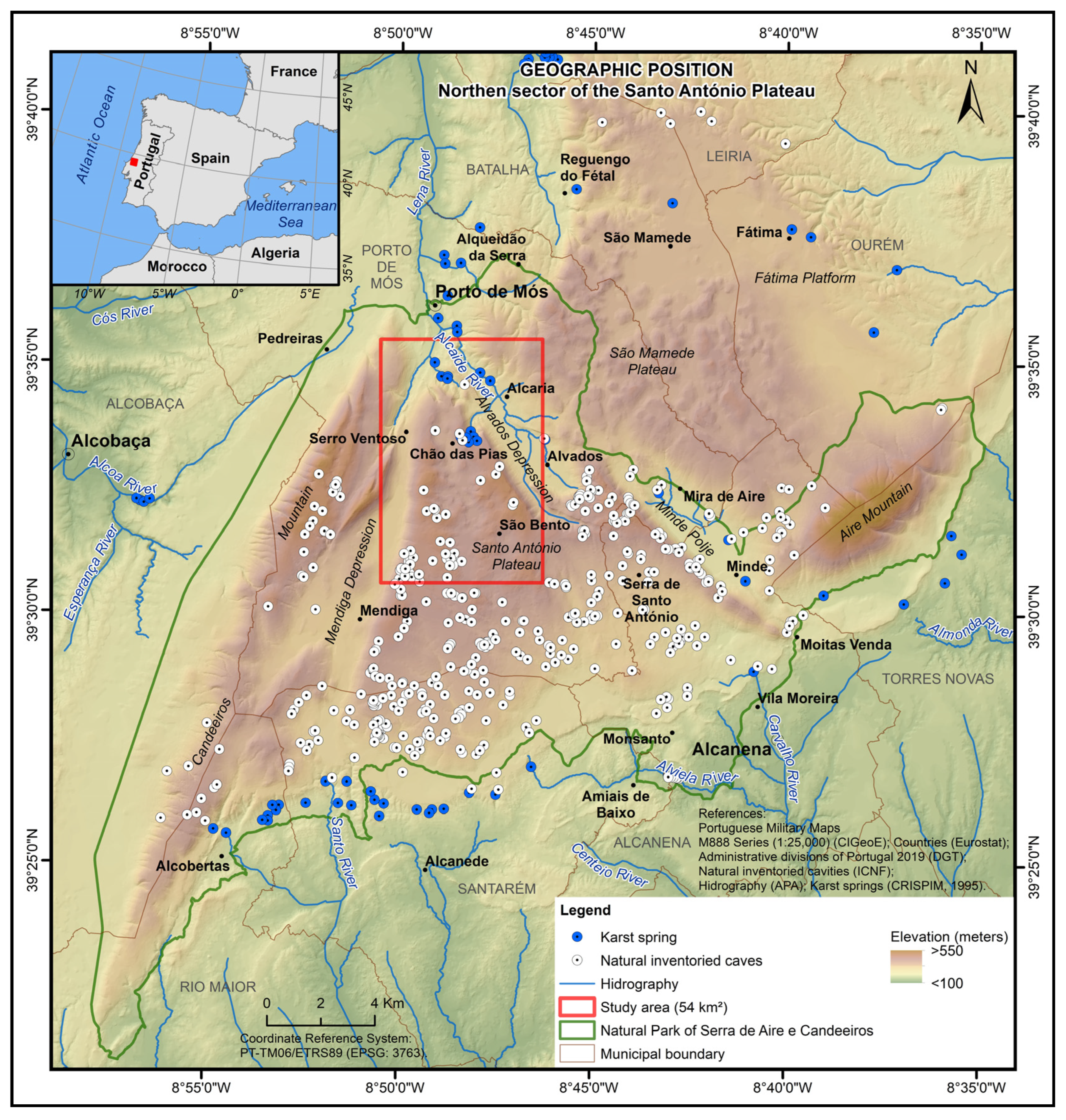
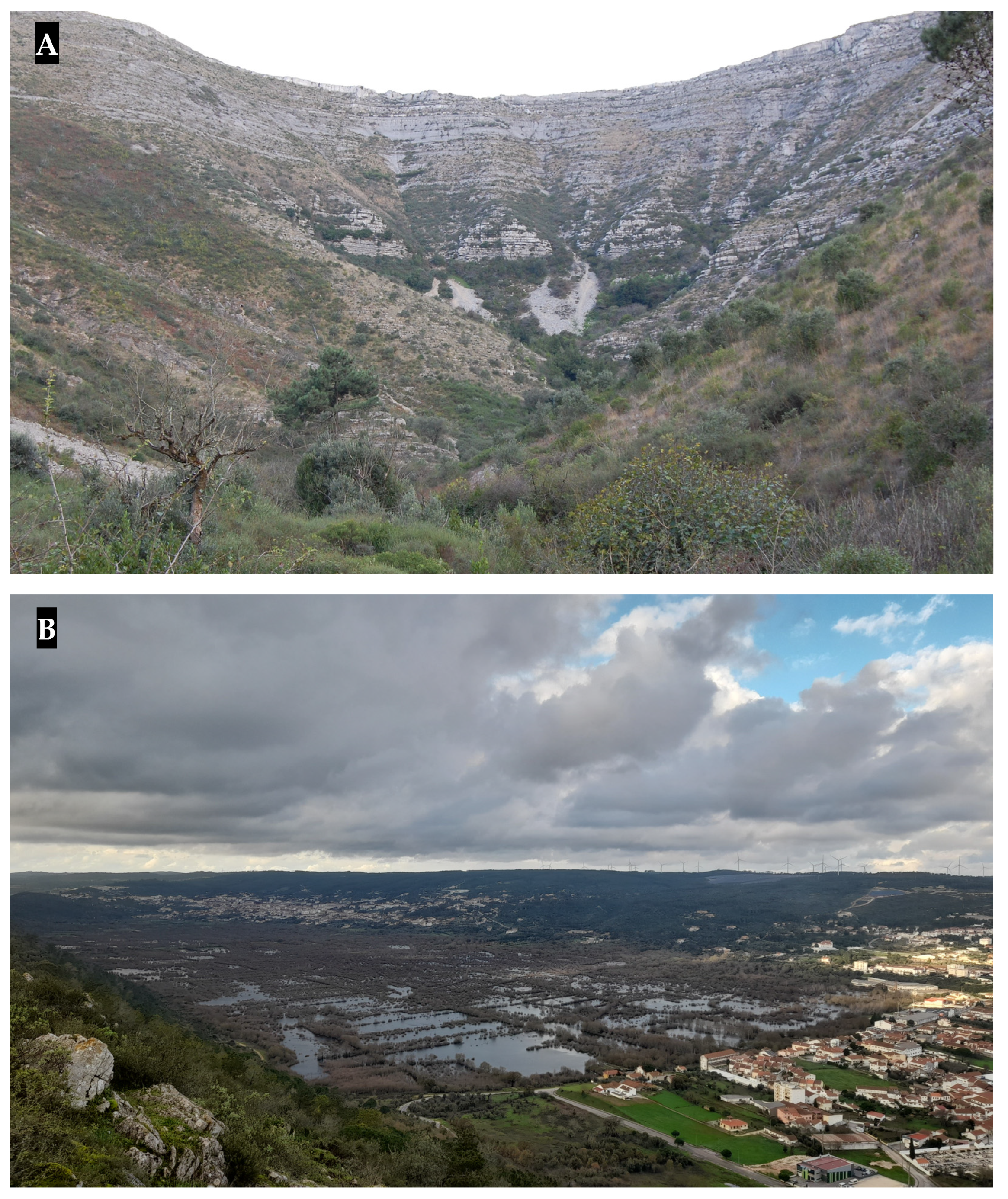
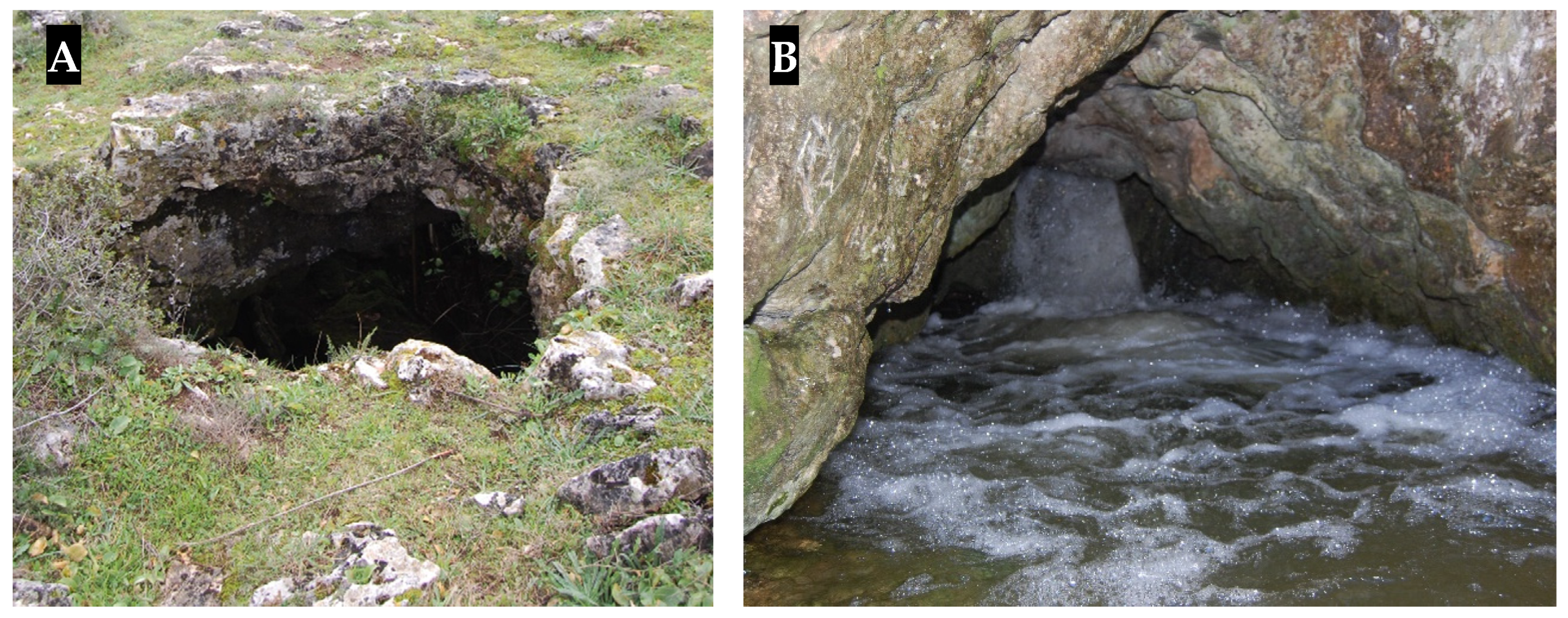

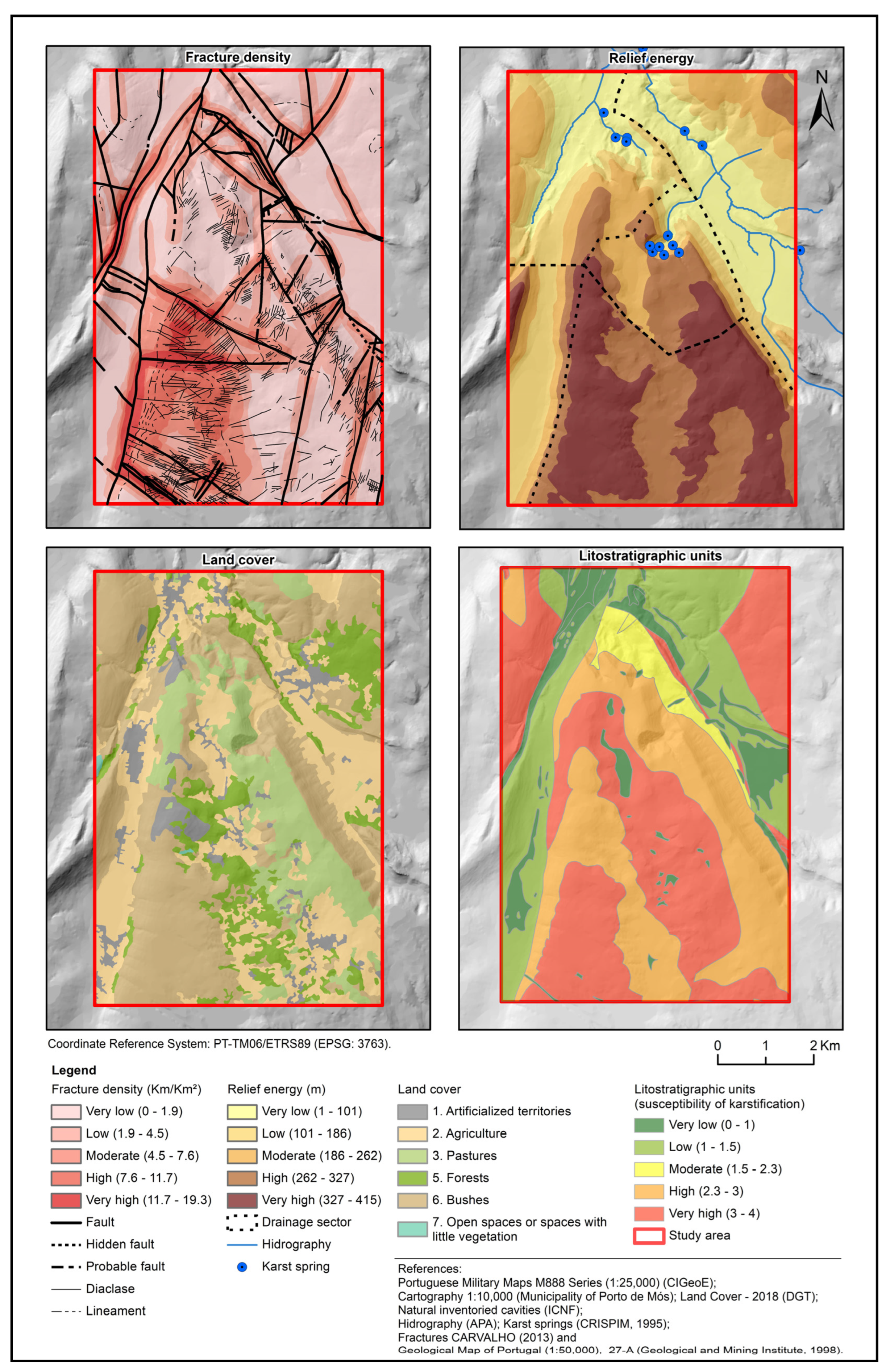
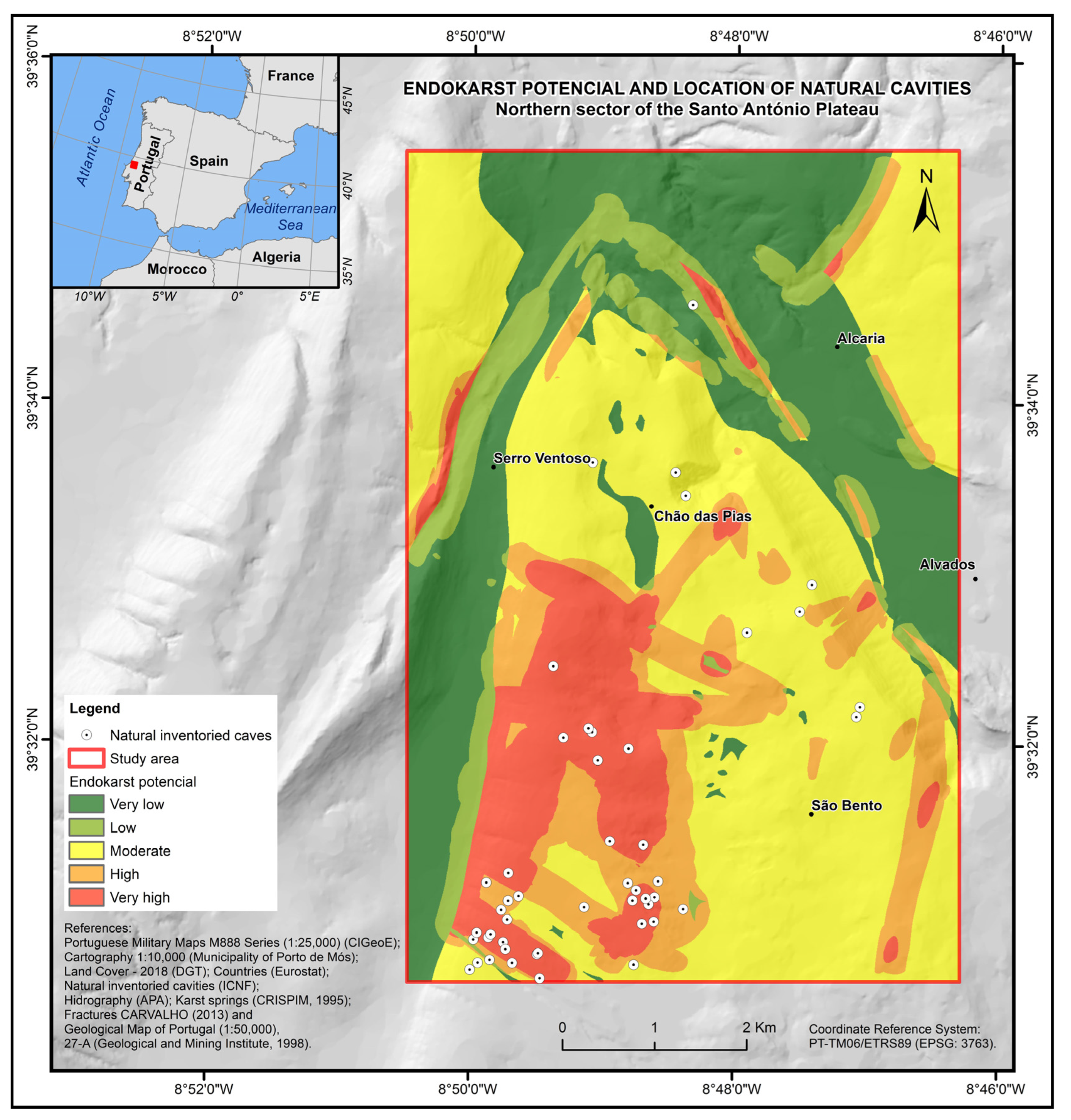
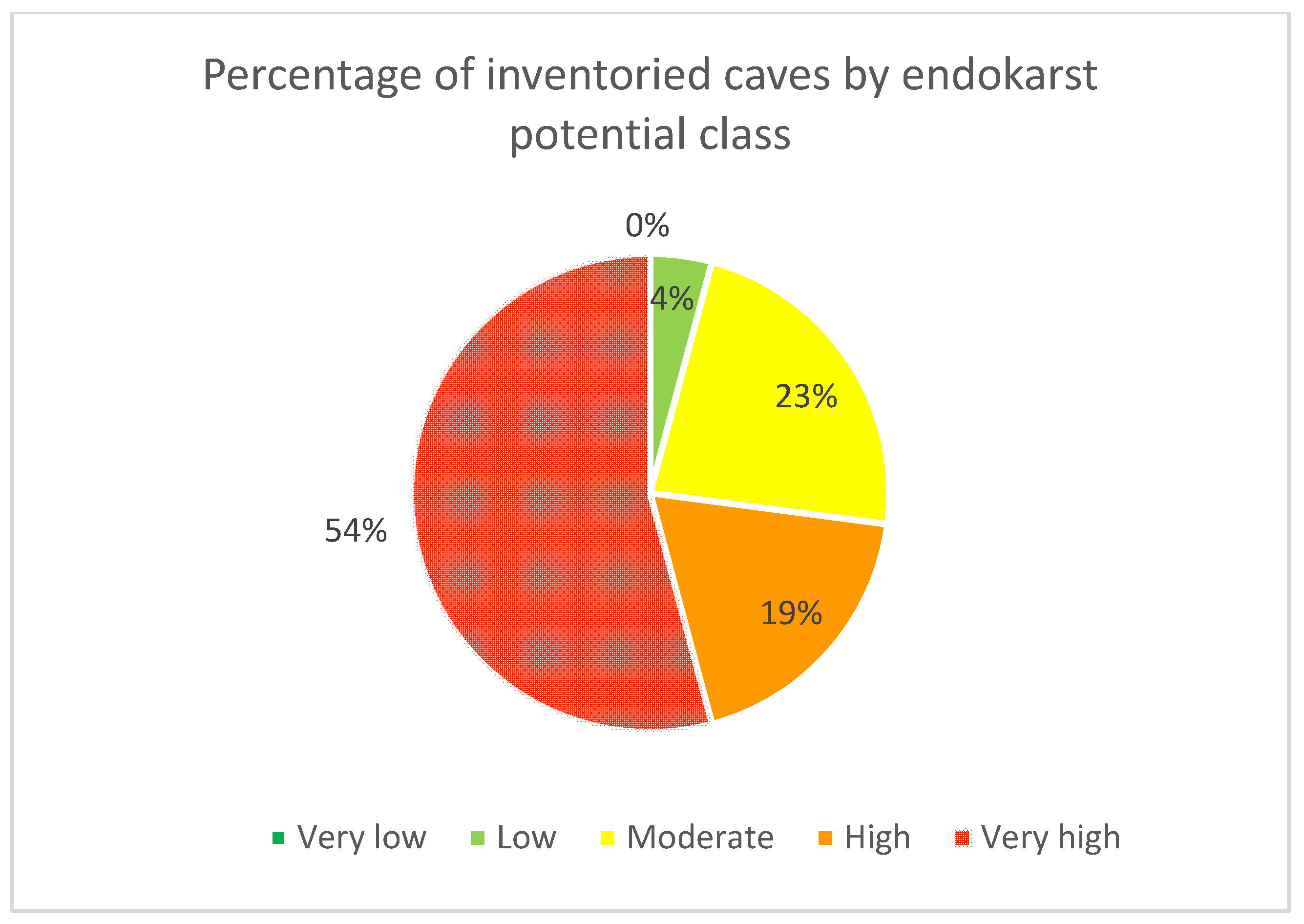
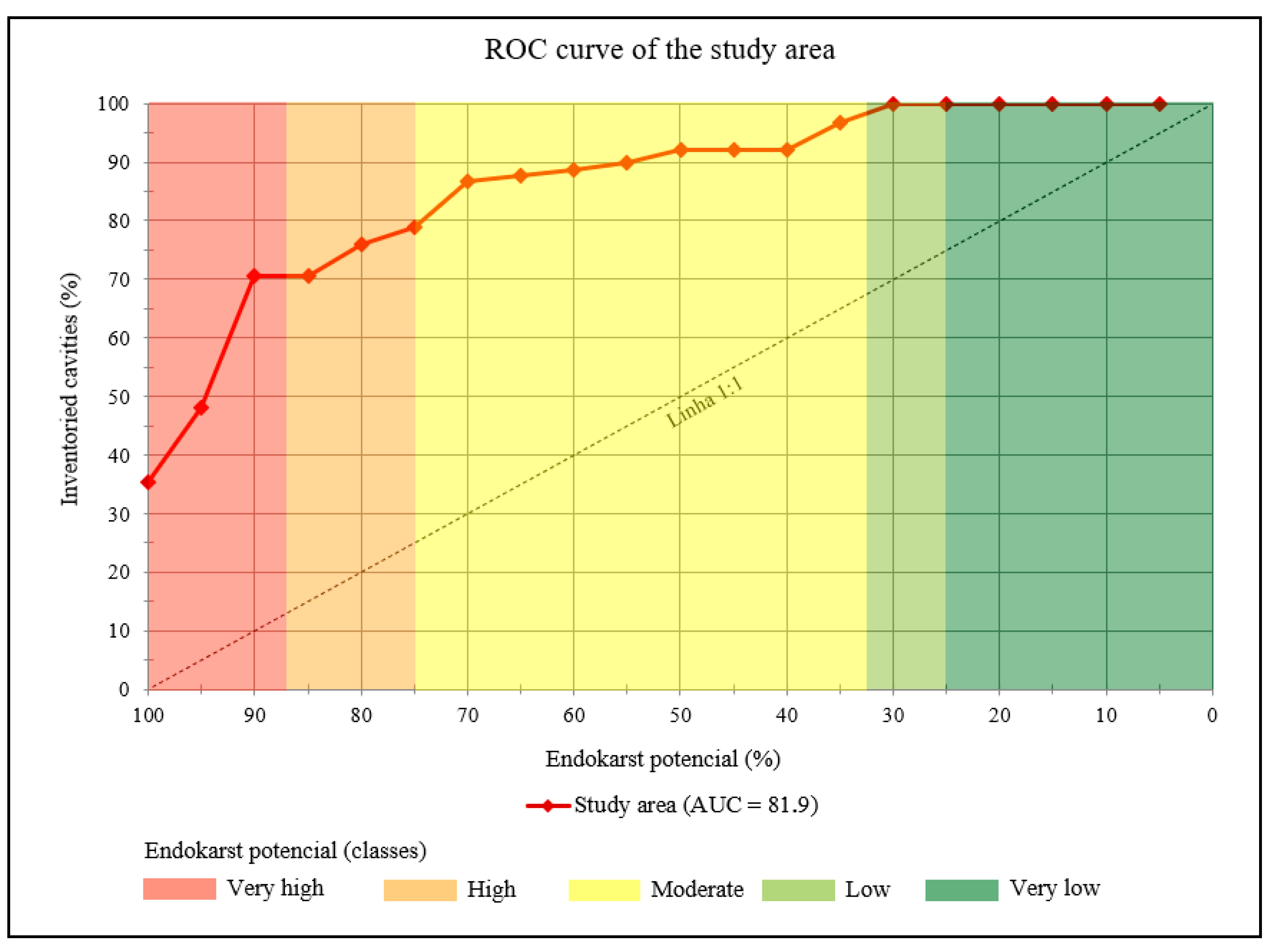
| Classification | Data Collection of the Study Area | Derived Raster Thematic Layer | ||
|---|---|---|---|---|
| (Spatial Database) | GIS Data Type | Scale or Resolution | Source or Citation | (Conditioning Factor) in a GIS |
| Geological data | Lithology (polygon-vector) A | 1:50,000 | IGM | Lithostratigraphic units |
| Strata geometry (point-vector) | 1:50,000 | Carvalho [59] | ||
| Tectonic structures (line-vector) | 1:50,000 | Carvalho [59] | Fracture density | |
| Topographic data | Contours (line-vector) B | 1:10,000 | PMM | Relief energy |
| Points elevation (point-vector) B | 1:10,000 | PMM | ||
| Hydrogeological data | Drainage sectors (polygon-vector) | 1:50,000 | Crispim [17] | |
| Karstic springs (point-vector) | 1:50,000 | Crispim [17] | ||
| Land cover data | Land cover (polygon-vector) C | 1:25,000 | DGT | Land cover |
| Speleological data | Karstic cave entrances (point-vector) D | 1:100,000 | ICNF | Location of known cave entrances |
| Intensity of Importance | Definition | Explanation |
|---|---|---|
| 1 | Equal Importance | The two criteria contribute equally to the objective |
| 3 | Moderate Importance | Experience and judgment moderately favour one criterion over the other |
| 5 | Strong Importance | Experience and judgment strongly favour one criterion over the other |
| 7 | Very Strong Importance | A criterion is strongly favoured, and its dominance is demonstrated in practice |
| 9 | Extreme Importance | The evidence favours one criterion over the other with a high degree of certainty |
| 2, 4, 6, 8 | Values associated with intermediate judgments | When you want a greater compromise between different levels of intensity |
| Criteria (Related to the Chosen Conditioning Factors) | C1 | C2 | C3 | … | Cn | |
|---|---|---|---|---|---|---|
| C1 | C1/C1 | C1/C2 | C1/C3 | … | C1/C1 | |
| C2 | C2/C2 | C2/C2 | C2/C3 | … | C1/C1 | |
| C3 | C3/C1 | C3/C2 | C3/C3 | … | C1/C1 | |
| … | … | … | … | … | … | … |
| Cn | Cn/C1 | Cn/C2 | Cn/C3 | … | Cn/Cn |
| Designation A | Lithology | SC B | Facies | Granulometry, Texture and Qualitative (Apparent) Porosity C | SC | Stratonomy D | SC | Bed Geometry E | SC | S—(Qualitative Assessment) F |
|---|---|---|---|---|---|---|---|---|---|---|
| Alluvium (a); detrital unit and terra rossa of Estremadura Limestone Massif (A) | Siliciclastic deposits, sometimes with a marly component | 0 | Pelitic and sandy fácies. | Pelites and sands with a generally clast-supported texture. Excellent porosity. | 0.9 | It does not show an apparent organisation in sedimentary beds. Still, a massive structure is filling the valley bottoms (alluvium) and some depressions and crevices of a karst nature (siliciclastic deposits with terra rossa). | 0 | - | 0 | 0.9 (Very low) |
| Beds of Alcobaça (J3AI) | Marls, sometimes siltstones, limestones, and sandstones | 0.2 | Mudstones, silty-sandy carbonate clays and silty-clay sandstones. | Pelites to matrix-supported sands containing various fossiliferous associations. Poor porosity. | 0.2 | Micritic limestones; silt-sandy carbonate clays with fine calcareous intercalations; micaceous sandstones from fine to very fine; beds of sandstones forming finer intercalations; thick beds of silty-sandy clays and silty-clay sandstones. | 0.2 | Thickness about 150 to 200 m; average slope 25°(min. 15° and max. 38°). | 0.3 | 0.9 (Very low) |
| Cabaços and Montejunto beds (J3CM) | Clay limestones and marls | 0.4 | Mudstones/wackstones related to rare packstones and grainstones. | Clay micritic limestones with the presence of carbonate microcrystalline matrix. Poor porosity. | 0.4 | Limestone and yellowish marls with ferruginous concretions; very bioclastic pelmicritic clayey limestone; clay-limestone; intraclastic micritic limestone; a monogenic conglomerate of limestone matrix; very bioclastic pelmicritic limestone. | 0.3 | Thickness about 65 m; average slope 34° (min. 8° and max. 85°). | 0.2 | 1.3 (Very low) |
| Limestones of Moleanos (J2MI) | Limestones | 0.5 | Rudstones, grainstones, Oolitic/bioclastic/oncolytics/lithoclastics packstones. | Absence of carbonate crystalline matrix with grains in contact. Porosity from poor to excellent. | 0.7 | Alternations of well-calibrated oolitic limestones and coarser calciclastics; compact, pelbiomicritic limestones; succession becomes more clastic, with massive calciclastic limestones. | 0.6 | Thickness is about 150 m, probably 180–200 m; average slope between 20 to 25°. | 0.6 | 2.4 (High) |
| Micritic limestone of Serra de Aire (J2SA) | Limestones | 0.8 | Mudstones and oncolithic wackstones with fenestrae and laminations; Floastones, wackstones and mudstones with algal/oncoid nodules and rusting. | Dolomitic levels, micritic and dolomicritic limestones with carbonate microcrystalline matrix. Porosity from poor to reasonable. | 0.8 | Cyclical sequences of micritic dolomitic limestones and limestones; compact micritic, fenestrated or oncolitic limestones, with ferruginous tinges; decreased fenestrated and oncosparitic limestones, becoming fossiliferous micritic limestones; biomicritic or pelimicritic limestones. | 0.9 | Thickness from 350 to 400 m; average slope 14° (min. 2° and max. 70°). | 0.8 | 3.3 (Very high) |
| Bioclastic limestone of Codaçal (J2Co) | Limestones | 0.7 | Oolitic and bio-intraclastic Grainstones with oblique bedding; Rudstones, grainstones and bioclastic/oncolytic/lithoclastics packstones. | Biolclastic and oobioclastic and sporadically dolomitised limestones with absence of carbonate crystalline matrix. Porosity from poor to excellent. | 0.8 | Fine oolitic limestones; oolitic limestones; bioclastic and oolitic limestones with intraclasts. | 0.5 | The average thickness is about 50 to 60 m, which tends to increase to 70–80 m; the average slope is 8° (min. 5° and max. 10°). | 0.9 | 2.9 (High) |
| Limestones of Chão das Pias (J2CP) | Slightly clayey or marly limestone, limestone, dolomitic limestone | 0.7 | Mudstones, wackstones and bioclastic packstones. | Presence of carbonate microcrystalline matrix. Poor porosity. | 0.8 | Slightly clayey or marly limestone in decimeter benches with siliceous nodules; succession characterised by the alternation of micritic and calciclastic limestones. | 0.7 | Thickness is about 50–60 m, reaching, however, values >80 m? Average slope 9° (min. 5° and max. 15°). | 0.9 | 3.1 (Very high) |
| Marls and marly limestones of Zambujal (J2ZA) | Marls, marly limestones, clayey limestones, limestones. | 0.4 | Mudstones, wackstones and bioclastic packstones. | Presence of carbonate microcrystalline matrix. Poor porosity. | 0.8 | Rhythmic alternation of marls, marly limestones, and clayey limestones, in almost always thin beds. The succession becomes increasingly thick and calcareous until the marly levels disappear. It appears significantly fractured. | 0.7 | Thickness about 220–250 m; average slope 14° (min. 4° and max. 34°). | 0.8 | 2.7 (High) |
| Marl limestones and marls of Fórnea (J1−2Fo) | Marls and marly limestones | 0.4 | Grumose; wackstones; biomicrites to biosparites/grainstone; packstones to grainstones. | Presence of carbonate microcrystalline matrix/absence of carbonate microcrystalline matrix with grains in contact. Poor to reasonable porosity. | 0.7 | Succession is dominated by thin to medium beds, sometimes without rhythmic organisation. From the top occurrence of biostromal bodies with metric thickness. Micritic limestones dominate the upper meters. | 0.7 | Maximum thickness with about 220–250 m; average slope 33° (min. 19° and max. 58°). | 0.5 | 2.3 (Moderate) |
| Beds of Coimbra (J1Co) | Dolomites | 0.5 | Wackstones to grainstones. | Presence of carbonate microcrystalline matrix/absence of carbonate microcrystalline matrix with grains in contact. Poor to reasonable porosity. | 0.7 | Cross-bedding and dolomites with parallel or wavy lamination, interstratified with pellets. | 0.4 | Thickness is about 60 m (beds with vertical or slightly inverted slopes). | 0.1 | 1.7 (Moderate) |
| Platelet dolomites (J1pi) | Dolomitic limestones | 0.7 | Mudstone | Micritic dolomitic limestone. Poor porosity. | 0.2 | Beds with centimetre to decimeter thickness. | 0.1 | Thickness is about 30–40 m. | 0.2 | 1.2 (Low) |
| Marls of Dagorda (J1Da) | Sandy loams, gypsum and saliferous clays, Intercalations of dolomitic limestones | 0.1 | Sandy, pelitic and Mudstones facies for the carbonate ones. | Poor porosity. | 0.1 | Tick saliferous series with frequent clayey intercalations; evaporitic salts with intercalations of evaporitic syngenetic dolomite and gypsum; occurrence of “Dolomites in platelets”; saliferous member, with domain of halite; saliferous/dolomitic member rich in evaporites–anhydrite and halite; dolomitic/margo-dolomitic limestones with red and greyish pelites and evaporites. | 0.1 | Formation subjacent Jurassic limestones with significant thickness, >3000 m, according to sounding “São Mamede 1”. | 0.4 | 0.7 (Very low) |
| Eruptive rocks | Dolerite | 0 | - | Poor porosity. | 0 | Associated with fractures or discontinuities. | 0.8 | - | 0 | 0.8 (Very low) |
| Lithostratigraphic Units (SK *) | Very High | High | Moderate | Low | Very Low | |
|---|---|---|---|---|---|---|
| Very high | 1 | 2 | 5 | 7 | 9 | 0.46 |
| High | 1/2 | 1 | 4 | 6 | 8 | 0.32 |
| Moderate | 1/5 | 1/4 | 1 | 3 | 6 | 0.13 |
| Low | 1/7 | 1/6 | 1/3 | 1 | 3 | 0.06 |
| Very low | 1/9 | 1/8 | 1/6 | 1/3 | 1 | 0.03 |
| Fracture Density | Very High | High | Moderate | Low | Very Low | |
|---|---|---|---|---|---|---|
| Very high | 1 | 2 | 4 | 6 | 9 | 0.47 |
| High | 1/2 | 1 | 3 | 4 | 7 | 0.30 |
| Moderate | 1/4 | 1/3 | 1 | 2 | 3 | 0.12 |
| Low | 1/6 | 1/4 | 1/2 | 1 | 1 | 0.07 |
| Very low | 1/9 | 1/7 | 1/3 | 1 | 1 | 0.05 |
| CR = 0.013 | ||||||
| Relief Energy | Very High | High | Moderate | Low | Very Low | |
|---|---|---|---|---|---|---|
| Very high | 1 | 1 | 2 | 3 | 4 | 0.32 |
| High | 1 | 1 | 2 | 3 | 4 | 0.32 |
| Moderate | 1/2 | 1/2 | 1 | 2 | 3 | 0.19 |
| Low | 1/3 | 1/3 | 1/2 | 1 | 1 | 0.09 |
| Very low | 1/4 | 1/4 | 1/3 | 1 | 1 | 0.08 |
| CR = 0.007 | ||||||
| Land Cover | Forests | Pastures | Agriculture | Bushes | Open Spaces or with Little Vegetation | Artificialised Territories | |
|---|---|---|---|---|---|---|---|
| Forests | 1 | 2 | 3 | 3 | 3 | 8 | 0.35 |
| Pastures | 1/2 | 1 | 1 | 2 | 3 | 8 | 0.22 |
| Agriculture | 1/3 | 1 | 1 | 2 | 2 | 6 | 0.18 |
| Bushes | 1/3 | 1/2 | 1/2 | 1 | 1 | 7 | 0.11 |
| Open spaces or with little vegetation | 1/3 | 1/3 | 1/2 | 1 | 1 | 7 | 0.11 |
| Artificialised territories | 1/8 | 1/8 | 1/6 | 1/7 | 1/7 | 1 | 0.03 |
| CR = 0.035 | |||||||
| Karstification Factors | Lithostratigraphic Units | Fracture Density | Relief Energy | Land Cover | |
|---|---|---|---|---|---|
| Lithostratigraphic units | 1 | 2 | 4 | 5 | 0.49 |
| Fracture density | 1/2 | 1 | 3 | 4 | 0.31 |
| Relief energy | 1/4 | 1/3 | 1 | 2 | 0.13 |
| Land cover | 1/5 | 1/4 | 1/2 | 1 | 0.08 |
| CR = 0.018 | |||||
| Factors (Criteria) | Classes | Area (km2) | N.º Caves | N.º Caves/Km2 |
|---|---|---|---|---|
| Fracture density | Very low | 21.99 | 5 | <1 |
| Low | 14.67 | 6 | <1 | |
| Moderate | 9.55 | 11 | 1.15 | |
| High | 5.24 | 19 | 3.63 | |
| Very high | 2.55 | 7 | 2.75 | |
| Relief energy | Very low | 11.66 | 0 | 0 |
| Low | 9.89 | 2 | <1 | |
| Moderate | 8.15 | 1 | <1 | |
| High | 11.81 | 9 | <1 | |
| Very high | 12.49 | 36 | 2.88 | |
| Land cover | Forests | 7.22 | 2 | <1 |
| Pastures | 7.81 | 4 | <1 | |
| Agriculture | 14.71 | 1 | <1 | |
| Bushes | 20.54 | 40 | 1.95 | |
| Open spaces or with little vegetation | 0.08 | 0 | 0 | |
| Artificialised territories | 3.64 | 1 | <1 |
Disclaimer/Publisher’s Note: The statements, opinions and data contained in all publications are solely those of the individual author(s) and contributor(s) and not of MDPI and/or the editor(s). MDPI and/or the editor(s) disclaim responsibility for any injury to people or property resulting from any ideas, methods, instructions or products referred to in the content. |
© 2023 by the authors. Licensee MDPI, Basel, Switzerland. This article is an open access article distributed under the terms and conditions of the Creative Commons Attribution (CC BY) license (https://creativecommons.org/licenses/by/4.0/).
Share and Cite
Reis, L.; Dimuccio, L.A.; Cunha, L. Assessing Endokarst Potential in the Northern Sector of Santo António Plateau (Estremadura Limestone Massif, Central Portugal). Sustainability 2023, 15, 15599. https://doi.org/10.3390/su152115599
Reis L, Dimuccio LA, Cunha L. Assessing Endokarst Potential in the Northern Sector of Santo António Plateau (Estremadura Limestone Massif, Central Portugal). Sustainability. 2023; 15(21):15599. https://doi.org/10.3390/su152115599
Chicago/Turabian StyleReis, Luís, Luca Antonio Dimuccio, and Lúcio Cunha. 2023. "Assessing Endokarst Potential in the Northern Sector of Santo António Plateau (Estremadura Limestone Massif, Central Portugal)" Sustainability 15, no. 21: 15599. https://doi.org/10.3390/su152115599
APA StyleReis, L., Dimuccio, L. A., & Cunha, L. (2023). Assessing Endokarst Potential in the Northern Sector of Santo António Plateau (Estremadura Limestone Massif, Central Portugal). Sustainability, 15(21), 15599. https://doi.org/10.3390/su152115599








